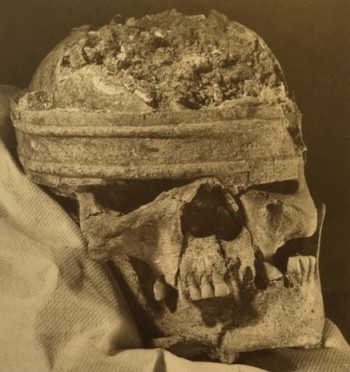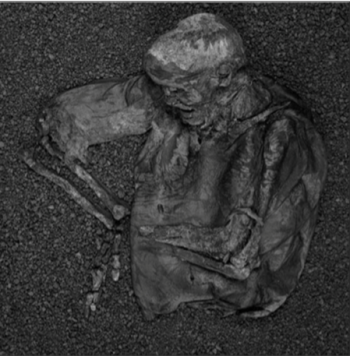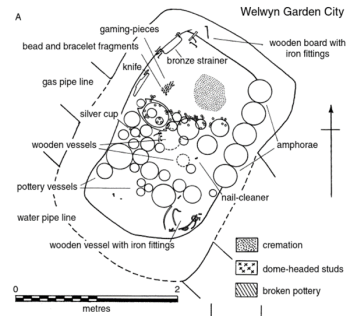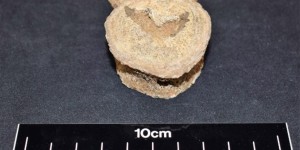Introduction
Lack of evidence for burial practices in Iron Age Britain has often led archaeologists to suggest that funerary rites of the period left no trace (Parker Pearson 2009, 5). The evidence that has been found demonstrates great variation but can be grouped into overarching trends. In the early and middle Iron Age, inhumation of both complete and incomplete remains was a dominant rite (Harding 2016, 8; Redfern 2008, 281), and were situated outside then inside a settlement respectively (Roth 2016, 9). By the late Iron Age, most individuals were buried as articulated inhumations (Redfern 2008, 281). Cremation was also present throughout the Iron Age, but it became the predominant convention in the later Pre-Roman Iron Age (Harding 2016, 8). Variations in these trends could be a result of social difference between the individuals of a community. This difference can be defined in many ways and those discussed in this research are age and gender differences, the status gained from wealth as well as political or leadership positions, as victims of ritual, and regional variations.
Age differences
Social difference is displayed in the variation of burials rites afforded to infants and children during the Iron Age. They were largely absent from regular cemeteries, and frequently found within settlement contexts associated with house structures (Harding 2016, 40). At Yarnton, Oxfordshire, all three of the neonatal skeletons were buried within the settlement area (Boyle 1999, 476), as were those at Gussage All Saints, Dorset (Tibbetts 2008, 191). Burial near house structures could suggest that the very young may have required protection after death. Tibbetts (2008, 193) suggests that burial within close proximity could help to ensure fertility for subsequent pregnancies (Tibbetts 2008, 193), though this idea is very difficult to prove. Comfort for the mother was likely to also have been a consideration when burying a child so close. The burial of infants in grain storage pits, however, could have been to ensure fertility for crop growth, as Hill (1995, 15) suggests. Infants were considered socially different so were not necessarily commemorated as an individual, but instead may have been used as a tool for the community’s benefit.
Non-adult remains have been found within cemeteries such as the 24 neonate, infant and child remains spread across King Harry Lane, Herefordshire (Harding 2016, 279). As well as the 55% of infants from the 1st century BC to the 1st century AD at Owslebury, Hampshire where they were buried as single deposits in specially cut graves (Tibbetts 2006, 191). Though the specific reasons have been lost to time, the commemoration in a similar style to many of the adults of the period suggests there may have been some criteria that needed to be met. Infants were also buried separately from older children and adults, showing further separation of age categories (Tibbetts 2009, 194). It should be noted that the fragility of neonatal remains means they are more vulnerable to being lost, and therefore are underrepresented in the archaeological record (McKinley 1997, 64), making definite conclusions about burial based on age difficult.
Wealth, Political or Leadership Positions
The social status of an individual could have been gained through wealth, or through political or leadership positions and reflected in the quantity and quality of grave goods buried with a particular individual. The burials of the Arras Culture provide examples of people believed to have achieved ‘warrior’ status, demonstrated by the rich assortment of grave goods they were deposited with (James & Rigby 1997,61). Cart or chariot burials could represent the highest level of social status, such as cart burial one from Wetwang Slack, Yorkshire, which was of a young male buried with many grave goods. These included a dismantled cart, chariot fittings, a sword and scabbard, and seven iron spearheads (Dent 1985, 87-8). Grave 112 from Mill Hill, Kent also provided a striking example of a high-ranking individual in the form of a bronze crown found in-situ on a male skull, see figure 1 (Harding 2016, 284). Determined to have provided no protection during battle (British Museum, 2019), it could purely have been a display of political power or leadership status (James & Rigby 1997, 24). However, this theory assumes that the items an individual was buried with belonged to them, and so is most likely an over-simplified interpretation.

It is possible that grave goods could have reflected social popularity, deposited as tokens of gratitude from mourners, or from those that depended on the individual, such as tenants (Harding 2016, 13). They could say more about the individual’s relationship with the community, potentially gained through positions of leadership, rather than merely their material wealth. However, it should be stressed that many graves in Iron Age Britain contain few, if any, grave goods (Harding 2016, 13), so they cannot be reliably used to infer many of the social differences of the person they are buried with. It is likely that high ranking individuals were buried without any grave goods, with other aspects of their burial rites demonstrating their status. A 3–4-year-old child buried at Gravelly Guy, Oxfordshire was found with a spearhead (Harding 2016, 13), which is unlikely to indicate that they achieved ‘warrior’ status, so might instead represent the child’s aspirations. Maybe they wanted to be like their father when they grew up.
Variations in the way infants were buried could also be indicative of differing social rank, or possibly the social rank of their parents. Evidence of graves lined and sealed with chalk have been found at Poundbury, Dorset (Tibbetts 2008, 193), a process would have taken time and effort, possibly reflecting a degree of recognition from the community. This provides a contrast to the disposal of infant remains within disused burial pits at Gussage All Saints (Tibbetts 2008, 193). Deposition in the pit could simply have been due to availability at the time of death, rather than evidence for some special treatment. This variation in treatment could be evidence for social difference, but given their young age, it is more likely that this social difference, or status, was passed down from the parents.
The location of burial could also be an indication of higher social status or indicate their importance to the community in which they were buried. Male burials at Gussage All Saints were found inside the settlement, roughly aligned with the entranceway (Tibbetts 2008, 191). This arrangement could suggest that this was a pathway through, possibly commemorating the settlement’s deceased leaders as it would have been visible to anyone entering.
Burials within a cemetery that have acted as a focus for subsequent burials are known as focal, or signal burials (Harding 2016, 127), and provide a further example of spatial distribution giving indication of social difference. As well as the warrior burials, those in special enclosures are another form of focal burial. The rectilinear enclosure from Period 3 of the Folly Lane Complex at Verulanium, Herefordshire, provides an example and hints at the complex funerary rite taking place. It included a subterranean shaft being systematically demolished- giving a definite end to the funerary ritual (Harding 2016, 145). The most plausible function for this elaborate burial site was surely for people to pay respects to a high-status individual. Its prominent location would have made the burial structure easily visible, though access would have been restricted (Harding 2016, 146), much like the memorials for people of leadership positions in more recent history.
Victims of Ritual
Burial evidence, including skeletal trauma and weapons, suggest that violence was a part of everyday life in the Iron Age (Roth 2016, 5). Some of this violence may have been human sacrifice during ritual activity, and Green (1998, 178 and 182) argues that it makes sense to interpret those sacrificed as people marginalised in society, especially due to their rarity. The value of the sacrifice could have been determined partly by the status of the individual - criminals may have been viewed as being of less value than prisoners of war, especially if those prisoners were of high status (Green 1998, 171). This can be hard to provide archaeological evidence for, but the poor diet of half of the adults and a quarter of the children found at Danebury Hillfort, Hampshire could possibly reflect their unfree status (James & Rigby 1997, 67). Their haphazard deposition in a charnel pit may also indicate their low social standing after having been singled out for sacrifice (Cunliffe 2003, 152).
However, Lindow Man II, see figure 2, could possibly be an example of a human sacrificial victim that was of higher value to the community. Examination concluded that his body showed no evidence of manual labour, so he could have been of higher status, and evidence of mistletoe in his stomach contents suggests a special drink or meal was given to him before being sacrificed (Hutton 2011, 140). It is widely reported that he was subject to a triple death (killing by three different methods) (James & Rigby 1997, 64; Green 1998, 173), and when taken with the other evidence, would suggest that his death was different to those of criminals. New evidence has shown that some of these injuries might have been inflicted post-mortem, making his death more comparable to that of a criminal (Hutton 2011, 140). It is obvious that those killed through ritual activity were picked due to some form of social difference, though these reasons would have varied depending on the context.

Regional Variations
Variation among Iron Age burial rites is seen regionally as well as temporally. For example, the Aylesford-Swarling cremation rite first appeared in the first century BC, concentrated largely in Southeast Britain, and is characterised by cremation burials in flat graves, typically in Cinerary earns, with associated material including pottery and brooches (Fitzpatrick 2007, 125). One of the earliest cemeteries of this type is that at Westhampnett cemetery near Chichester, where 161 graves were found dating to 90-50 BC (Sharples 2010, 284). Social difference seems to be present in this cemetery, with a group of large square pits with larger assemblages of grave goods, and smaller burials arranged around them (Sharples 2010, 287). This arrangement has been suggested to indicate family groups, such as an elder surrounded by his family. This idea has been debated, though the arrangement certainly seems significant (Sharples 2010, 287). The similarity of this rite to burials in Northern France has led to beliefs that its emergence was a result of migration (Roth 2016, 10). These individuals would have been socially different as they would have been foreign, bringing their traditions with them. However, this idea has been questioned due to the presence of cremation in the area prior to the introduction of this rite (Roth 2016, 10). It is more likely to reflect a connection between Southeast Britain and the Continent, specifically Gaul and Italy (Roth 2016, 11), and the movement of ideas and objects as well as people.
Even within this regional burial type, variation is present possibly due to social difference. The Welwyn-type burials are a sub-category interpreted as elite burials due to the presence of imported goods (Fitzpatrick 2007, 127). These prestigious goods from the continent could only be afforded by the wealthy and used to demonstrate their social status in death. Finds at the Welwyn-type grave at Welwyn Garden City, Hertfordshire, included five amphorae, a Roman silver cup, and 36 pots as well as cremated remains, see figure 3 (Fitzpatrick 2007, 131). The act of cremation was also more expensive than inhumation (Fitzpatrick-Matthews 2007, 151), which along with the goods, demonstrates the high social standing of the individual buried there, and the rapid social change taking place during this period. It is likely that more high-status individuals, who were able to have contact with the continent, would have been subject to the rapid Romanisation that was taking place, sooner than those more rural and possibly lower social standing communities.

Conclusion
Burial data from Iron Age Britain shows that individuals were buried in different ways. Social difference is likely the reason for this, with the variation in social status from wealth or political and leadership positions providing the strongest archaeological evidence. It is probable that the higher the quantity and quality of grave goods, the higher the status an individual held. However, it must be considered that these interpretations have often been over simplified, as the dead do not bury themselves, and the opinions of those burying the individual could also play a role in the deposition. These grave goods could have been gifts from mourners as well as the personal belongings of the deceased. The current evidence for age differences seems to suggest that there was a social distinction between individuals of different ages regarding how they were buried, but the fragility of non-adult remains could mean that this was not as prevalent as the archaeological record suggests. The interpretation of ritual burials should always be approached with caution, as there is no substantive evidence for why individuals were singled out for this treatment. It should also be noted that the burial evidence currently available is by no means representative of the entire Iron Age population. This could mean that the burial evidence only shows the most socially distinct people of society, whether they be the highest leaders or the lowest ranking, such as criminals.





